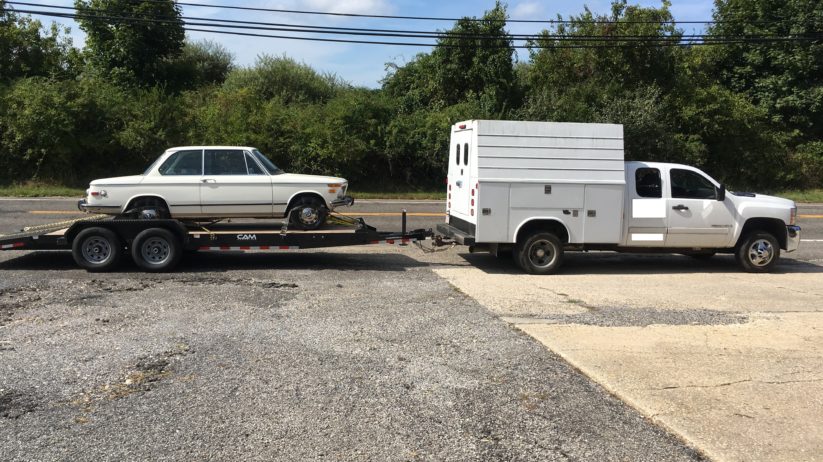Last week, I described driving down to Bridgehampton with a truck and trailer to look at an original-owner ’73 2002 with 48,000 miles on it that had been sitting in rented barn storage since 2008. I found it to be as rust-free as the owner claimed it was, and it had a remarkably well-preserved interior. However, a series of blemishes on the body that were less than dents but more than dings, and a regrettable engine compartment that, in addition to showing all 46 years of its age, had what looked like black paint sprayed in places where it wasn’t supposed to be, made the overall condition of the car closer to “very good.” The car was in a barn whose orientation relative to the narrow tree-lined driveway would’ve made it difficult if not impossible for me to back the trailer directly up to it and winch the car on (any shipper would’ve likely required the car to be put out on the street for pick-up). I did a careful restart of the car, got it running off fresh fuel poured directly into the carburetor’s float bowl, and got it moving by filling the empty brake reservoir with fresh fluid and bleeding the clutch into a cardboard box lined with paper towels. The combination of these two things made me think that I could simply drive the car out of the barn and onto the trailer. After a three-hour-long negotiation with the seller, I bought the car, but it was late enough that loading it and driving six hours back to Boston were out of the question, so I drove to my son’s father-in-law’s sister’s house in Southampton to spend the night.
In the morning, I returned to the scene of the crime. As I’d done the previous day, I drove the truck and trailer down the long narrow driveway, around the turn-around circle in front of the other (apparently empty) large house at the end, and positioned it facing up the driveway to receive the car. Then I knocked on the door of the house where the car was. The owner, King, who I’d met the day before, came out. He told me that at some point, he and his wife needed to go out to the market, so the truck would need to be moved, but that I probably had several hours before that happened. With that, I set about to load ‘er up.
Now, when I say that I had gotten the car “running” and “moving,” let me be clear. “Running” meant that, with fresh gas in the float bowl and with the mechanical fuel pump disconnected so it wouldn’t suck old gas from the tank, I’d started the car for the first time in eleven years, let it run for five seconds, and shut it off before its leaking water pump dumped more coolant on the barn floor. “Moving” meant that, with fluid in the brake reservoir and the clutch bled, I’d started the car a second time, put it in gear, moved it a foot forward, put it in reverse, moved it a foot backward, and shut it off. On the basis of this, I was pretty confident that I could back it out of the garage and drive it onto the trailer, but it’s not like I had the car slinging gravel up the driveway and heading for the beach.
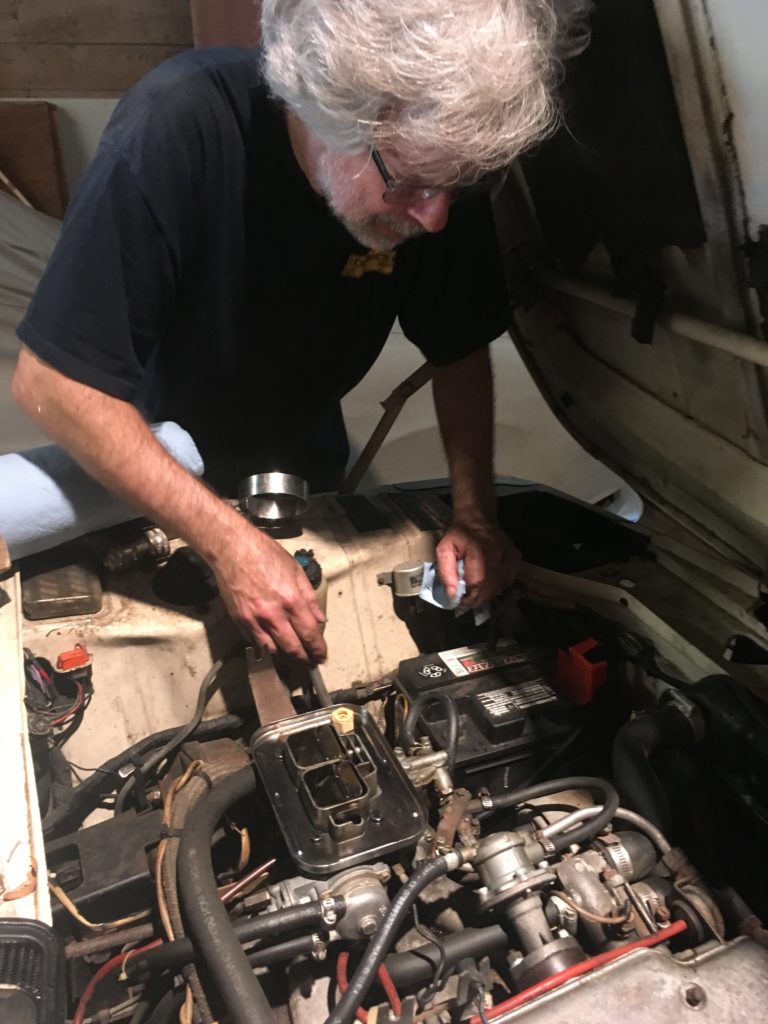
Preparing for the restart.
I dropped the spare battery back in, pumped the accelerator pedal a few times, twisted the key, and smiled as the car fired up once more. But as I prepared to back it out of the barn, it died and wouldn’t restart. I figured that maybe I’d already used up the gas I’d poured into the float bowl the previous day, though that seemed unlikely with only three starts. I unscrewed the top of the carb again, refilled the bowl even though it wasn’t empty, buttoned it back up, and started it. As soon as it held rpm, I mashed the clutch, popped it into reverse, zoomed backwards out of the barn and over the small lawn in front of the door, hooked the back end down the driveway, put the nose of the car about fifteen feet behind the trailer, and shut it off. King, the homeowner, was watching, and literally applauded the sight of the tidy Chamonix (white) little car moving out of the barn under its own power into sunlight for the first time since the market downturn of 2008. (He was probably applauding that one of the seller’s two cars was finally out of his barn.) Me, I was thrilled that I’d be able to drive the thing onto the trailer and wouldn’t have to deal with running a long extension cord into the barn to power my Warn PullzAll portable winch.
Or would I?
I extended the truck’s ramps. This required unclipping the safety pins from the little doors behind which the ramps are stowed. I remember the pins being a little unusual. In addition to the dowel, there was a circular clip and a flat spot, the whole thing looking like one of those old rod-and-rope puzzles. They fit securely into their holes, but once I removed them, it wasn’t clear exactly how they locked back in. Like an idiot, I didn’t photograph them first. But they were just pins; how hard could it be to lock them back in? Anyway, I was a man on a mission. I left the issue for when I needed to stow the ramps.
I jumped back in the car and re-started it. It idled for several seconds, then died. Again I pumped the accelerator pedal, again it started, but I could not seem to get it to hold an rpm at which I could pull it onto the trailer. It seemed unlikely that the float bowl was empty again, but if it was, I didn’t want to keep going through the hassle of manually refilling it. I’d brought an electric fuel pump with me, the one that had been in Bertha for 30 years —you’ll read a funny story about it in the upcoming December issue of Roundel. I temporarily installed it in place of the mechanical pump, stuck its inlet hose into the can of clean gas, connected it to a wire that had an alligator clip at the other end, clipped it to battery positive, touched the body of the pump to the engine to make ground contact, and smiled as I heard the fuel pump move gas out of the can and into the float bowl. It was especially cool to hear the note of the pump change as the float bowl filled and the needle valve closed. I’ll admit that, standing next to the hood of this little jewel of a car in a driveway in Bridgehampton on a sunny September morning, I patted myself on the back for the efficient and effective application of my 35 years of 2002-related experience. In fact, I was insufferably pleased with myself.
That is, until fuel sprayed everywhere from the split in the fuel hose leading into the Weber. I imagined the idyllic self-congratulatory little scene turning into a dumpster fire, with a headline in the local Hamptons newspaper reading “New Idiot Owner Accidentally Immolates Long-Dead Vintage BMW. Borrowed Trailer Also Burns.” (News at 11.)
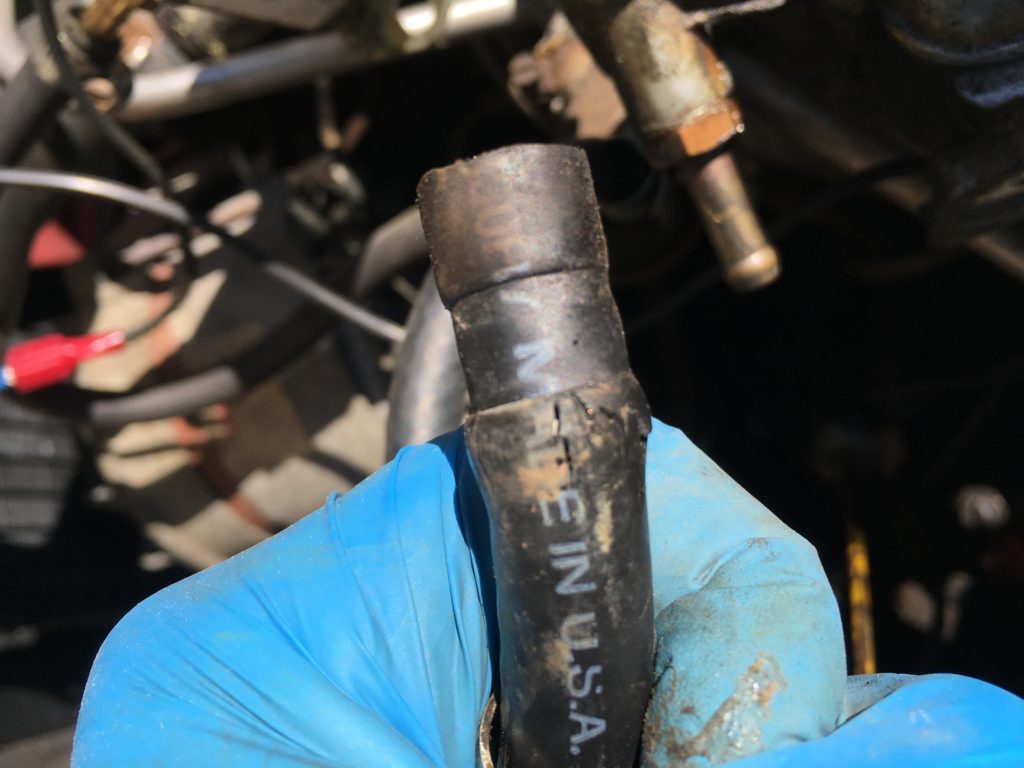
I didn’t see this until gas began spurting out of it.
I kid, I kid. It really wasn’t very much fuel. I disconnected the fuel pump, cut off the split part of the fuel hose, reattached it, pulled the fire extinguisher close, and tried to start the car. Again it fired up, but would not idle.
King came back out of the house and offered to help me guide the car straight up the ramps and onto the trailer. I explained that that’d be great as soon as the thing would stay running. I probably tried restarting it ten times, stopping occasionally to re-connect the fuel pump and refill the bowl. I was about to give up and pull out the winch and the crate of extension cords when, finally, it seemed to hold steady at 3000 rpm. I hastily put it into gear, let out the clutch, and drove up the ramps with such urgency that King, who was on the deck of the trailer guiding me, quickly jumped out of the way.
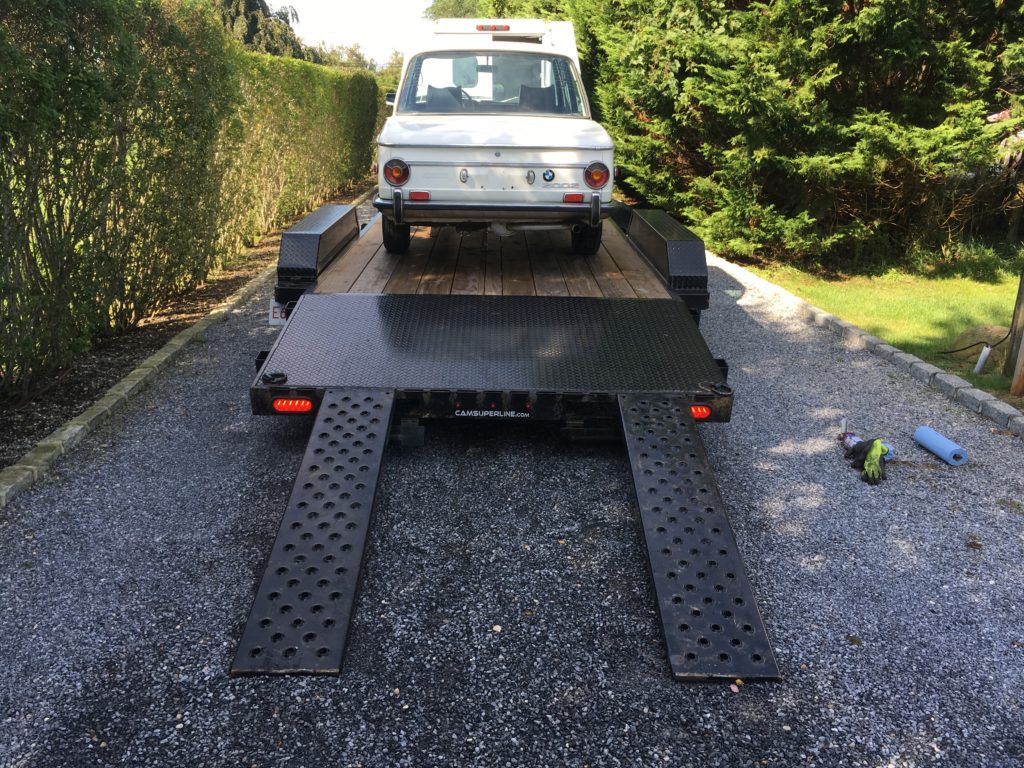
Whew!
With the car finally on the trailer, I began the strap-down. U-Haul auto trailers have the advantage that there’s only one way to strap a car onto them, with integrated wheel nets on the two front wheels, and a safety chain over the rear subframe. Other trailers I’ve used have D-rings in the bed at regular intervals. But this trailer that I’d borrowed from my friend Wink Cleary was more of a construction equipment trailer. It had D-rings at the very front and back, but none in the bed itself. There were rectangular channel attachment points on the side, but it wasn’t clear to me how to use them. Wink had given me a big Rubbermaid container of attachment hardware. I looked inside and found not only straps, chains, but big ratchet binders. It wasn’t at all clear to me how they needed to be used. I texted Wink and asked “Hey, exactly how do you use all this stuff to strap down a car?” Wink replied “Actually, I don’t know. It’s a new trailer. I just bought it. I’ve only strapped my tractor to it.”
I had brought a set of wheel nets with me. These clipped securely into the D-rings in the very front of the trailer and went over the front wheels, but clipping the other ends into the boxed attachment points on the side wasn’t reassuring, as the spring-loaded safety latches couldn’t close around them. I ran some chains to the rear-most D-rings and clipped the other set of wheel nets to those, but there was nothing to attach their other ends to. I wound up running a chain laterally across the deck of the trailer and clipping the forward ends of the rear wheel nets to it. Then I used two ratchet straps as safeties, one wrapped several times around the rear subframe, the other pulled over the long bolts that affix the lower control arms to the front subframe.

This attachment point, with a hook whose safety latch encloses a D-ring, is secure. It shouldn’t unhook even if the chain slackens.

This attachment point is not secure. If the strap slackens, the end can come unhooked. But it was all that I had.
At this point, King said that he and his wife needed to go to the market and asked me if I could move the rig. I thanked him for his hospitality and his patience, slid the ramps into their slots in the trailer, flipped their doors shut, and hastily put the pins back in their holes. I knew I hadn’t yet figured out the correct way to secure them. I made a mental note to re-do it after I’d moved the trailer.
I drove the rig up the long driveway and out onto the street, and saw that, at the corner, was a big flat parking lot for a construction business that was closed on Sunday. I pulled in, double-checked all the strapping, and tightened everything down, but forgot about the issue of the pins on the ramp doors.

Ready to begin the long trek home.
When trailering a car, it’s important to stop after you’ve been underway for a little while and tighten the straps, as they slacken from both stretch and a shifting load. Once things settle, they’re usually stable. I stopped after two miles, and again at ten. As I approached the entrance for the Long Island Expressway, I stopped at a gas station to fuel up and check the straps a third time, knowing that there wouldn’t be convenient rest areas until I got well north of the city.
As I pulled in and drove through a drainage swale around the perimeter, I heard a metallic BANG. I didn’t think much of it, as the slide-in ramps on any trailer make a racket over bumps. At worst, I thought the very back of the trailer had briefly hit the concrete from the swale. But while I was fueling up the truck, I looked behind the trailer, and saw that one of the ramps was lying on the concrete and the other was ready to do so. Then I realized that I’d forgotten to figure out how to properly install the pins that held the ramp doors closed. I felt like an idiot. Thank heaven it happened in a gas station at 2 mph and not while on the highway.
I quickly stowed the ramps back inside their slots and pulled the rig into a parking spot. The securing pins were long gone. I needed something else to secure the little doors. I rooted around in the truck’s utility body and found a few nuts and bolts. For redundancy, I installed a heavy-duty zip tie on each one.

Belts and suspenders on the ramp doors.
After checking the straps again, I hit the highway. I recalled from the drive down that, from Yaphank up through the city and north to Mamaroneck, the expansion joints were merciless, creating an incessant ba-BANG! ba-BANG! that went on for forty miles. While most of this was simply due to the slide-in ramps, each ba-BANG! made me imagine my just-purchased-but-not-yet-insured 2002 ending up in the weeds. When I stopped at the first available rest area, I was alarmed to see that my paranoia was in fact justified. There were six straps on the vehicle (four wheel nets and two safety straps). Each strap has two ends. Of the twelve ends, four of them had become detached, and the safety strap around the rear subframe was cut nearly all the way through from rubbing on a sharp corner.
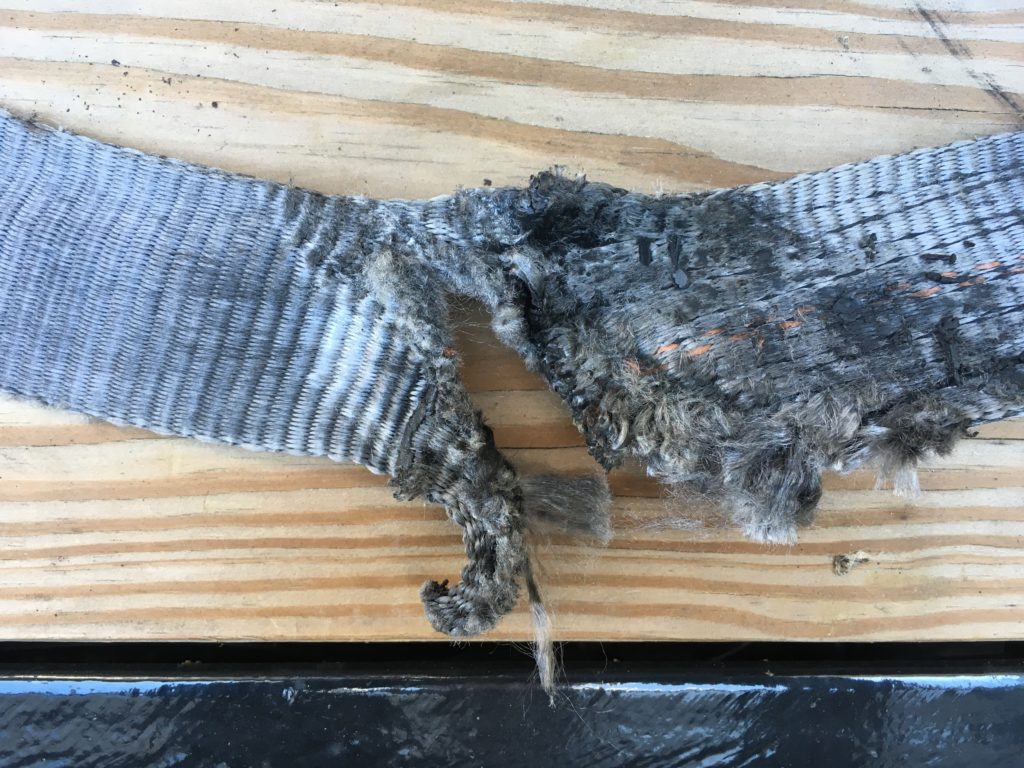
This safety strap was no longer, uh, safe.
While the load wasn’t actually in any danger of coming loose (not yet anyway; this is why you stop and check), I resolved that never again would I use a trailer without knowing that I had a set of straps with ends that clipped securely all the way around their attachment points so the couldn’t come loose even if the straps slackened.
Once I got past the old concrete sections of highway, the drive went smoothly. I got home, eased the car off the trailer, and dropped it in my driveway.

The new car meets its siblings.
It took me a few days to get the trailer back to Wink up in West Newbury. I described my travails with the magic self-removing ramps, and told him that new pins and a pair of new straps to replace the two that I’d completely gummed up were on order for him.
Wink, who has a patina’d 2002 named “Relic,” asked me if the new car had a name. I told him with some embarrassment how the seller informed me that the car was named “Baby,” and how I said that I couldn’t call it that, that my car guy friends would never let me hear the end of it.
“Hampton,” Wink said.
“Pardon?”
“The car’s name. You should call it Hampton.”
It was perfect. Plus, after loaning me a trailer, Wink totally deserved the naming rights. Hampton it is.
So, 600 round-trip miles from West Newton to Bridgehampton. Two hundred more miles to pick up and return the borrowed trailer, and another 50 for the borrowed truck. One day down, one day back, two more days on the shoulders. That’s a lot of time and miles to buy a car that I did not crave, certainly did not need, that looks just like another 2002 I already have in the garage, at a price that, while lower than market value, was far from a steal. Was it worth it?
It’s too early to say. But, as Tom Petty sang, it’ll all work out, eventually.—Rob Siegel
(Next week: The sort-out begins.)
_________________________________
Rob’s new book, Resurrecting Bertha: Buying Back Our Wedding Car After 26 Years In Storage, was just released and is available on Amazon here. His other books, including his recent Just Needs a Recharge: The Hack MechanicTM Guide to Vintage Air Conditioning, are available here on Amazon. Or you can order personally-inscribed copies of all of his books through Rob’s website: www.robsiegel.com.

